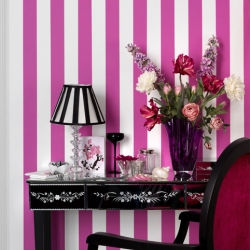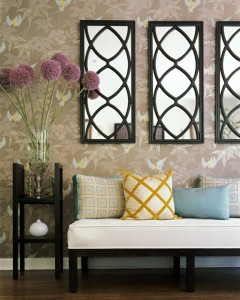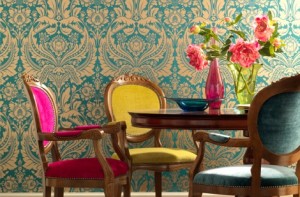
Decorating can be a time consuming exercise. Done with the right attitude, the process can be quite engaging and stimulating. However, no-matter how enjoyable the actual décor activities are, it’s the outcome that is judged. Many times, it’s a case of the end justifying the means.
Your wall décor, particularly, sets the pace for the rest of your interiors. If poorly done, it will stick out like a sore thumb for all and sundry to see. So should you ever find that you want a fine wall décor job yet are challanged either financially or time wise or skill wise, then, you may want to turn to wallpaper. As an alternative to paint finishes, wallpaper is a cheaper and quicker alternative. It also requires almost no special skill to deploy. However, just like any other décor element, it’s possible to get it all wrong if prior thought and creativity is not employed. Let’s look at some wallpaper décor tips.
Wallpaper Colour
Solid Colours work best in rooms with elaborate furniture or decoration. This avoids clashing, tones down the fancy décor and brings attention to the important pieces in the room.
Light Colours are best suited for smaller rooms and living areas. They make the space appear larger than it is. Again, it highlights hanging art and fancy accessories to the room. Light colours also provide a sense of warmth, which works well in family-centered areas.
Dark Colours do the opposite of light colours. While they can make a room feel cool and relaxed, they also make spaces seem smaller than they actually are. To avoid too much cramping, consider only wallpapering one or two walls, always leaving the ceiling alone. Dark colours may work best in a dining room, where a relaxed atmosphere is ideal.
Wallpaper Patterns

Patterns operate as shields, hiding bumps and other imperfections on your walls. They also serve as eye-catchers, appealing on their own as decorative contributions. As a general rule, avoid dark patterns as they often come off as dated and cluttered. Patterns in lighter, brighter colours are better for adding a splash of creativity without appearing old. Some common patterns include;
- Repeated/floral patterns are the most common “shield” wallpapers. They work well for smaller rooms, such as guest rooms as they highlight the limited space. In bigger rooms, it is best to limit floral patterns to one wall. Floral wallpaper is recommended to accompany simple, limited room décor.
- Large patterns create a visual appeal that supplement the existing room décor, hence making a space cozier and intimate. Many people use large patterns in larger living areas to make them feel less intimidating. Be sure to choose colours, designs and shapes that match your existing furniture.
- Small patterns work well in small spaces as they add volume to the room. Small patterns can also call attention to specific hues if chosen with specific colour schemes in mind.
Stripes are extremely bold designs and should therefore be limited to a maximum of two walls per room. They should also never be used on opposite or adjacent walls in the same room as this would clash and possibly make one wall appear larger than the other.
- Vertical stripes create the illussion of height to a short room. This typically works best with two colours from the same hue, because simpler is better for space expansion. Vertical stripes can also add a dash of flair to a child’s room or a library area.
- Horizontal stripes elongate the walls in narrow spaces like a small closet, making tight spaces appear larger than they are. If you choose to use horizontal stripes in a large living area, restrict them to one all to avoid making the room appear too short.

Wallpaper Features
- Scrubbable wallpaper can withstand brush scrubbing and mild detergent and are therefore ideal for family homes.
- Washable wallpapers have acrylic coating, making them sponge safe. They are useful in bedrooms and living rooms where furniture is placed close to or directly against the wall.
- Textured/embossed wallpaper work well with big spaces and on uneven walls. Some textured wallpapers can even imitate certain materials, such as leather or metal. Many designers use textured wallpapers in children’s rooms for visual stimulation.
- Faux surfaces/landscape wallpaper can replicate the appearance of any setting on your wall, from a log cabin to a rocky terrain. Many people like to use these in game rooms or children’s bedrooms to add flavor and creativity.
Where Not to Put Wallpaper
A combination of heat, sunlight, moisture and grime make wallpaper unsuitable for the following areas:
- Outside
- Bathroom
- a small kitchen
- Under excessive direct sunlight
Posted by Pambo Maridadi @ Crown Paints Kenya Ltd Email: info@crownpaints.co.ke






